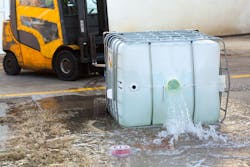In Part 1, we looked at the “hold while using” method of preventing small spills. You can easily hold a small solvent can in your hand while using it and easily place it on a cart when not. Try that with even a one gallon paint can, however, and you will quickly fatigue. Another tip for small container use is to seal the container lid if you plan to set the container down for a while.
But what if you have a larger container? A lift truck or maintenance cart might knock over a larger container. Or, someone might stumble into it, causing a spill.
You can apply the same working procedure noted above for small containers to any larger container. In other words, don’t use the large container as your working container. Use a funnel, pour spout, or similar means to fill a much smaller working container. The only time the larger container is open is when you need to refill your small working container. If it’s knocked over while sealed, there’s no spill.
About the Author

Mark Lamendola
Mark is an expert in maintenance management, having racked up an impressive track record during his time working in the field. He also has extensive knowledge of, and practical expertise with, the National Electrical Code (NEC). Through his consulting business, he provides articles and training materials on electrical topics, specializing in making difficult subjects easy to understand and focusing on the practical aspects of electrical work.
Prior to starting his own business, Mark served as the Technical Editor on EC&M for six years, worked three years in nuclear maintenance, six years as a contract project engineer/project manager, three years as a systems engineer, and three years in plant maintenance management.
Mark earned an AAS degree from Rock Valley College, a BSEET from Columbia Pacific University, and an MBA from Lake Erie College. He’s also completed several related certifications over the years and even was formerly licensed as a Master Electrician. He is a Senior Member of the IEEE and past Chairman of the Kansas City Chapters of both the IEEE and the IEEE Computer Society. Mark also served as the program director for, a board member of, and webmaster of, the Midwest Chapter of the 7x24 Exchange. He has also held memberships with the following organizations: NETA, NFPA, International Association of Webmasters, and Institute of Certified Professional Managers.
